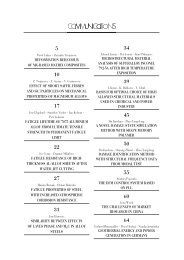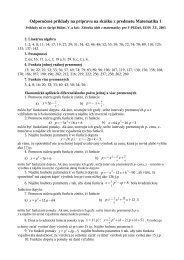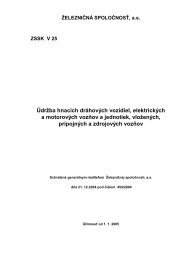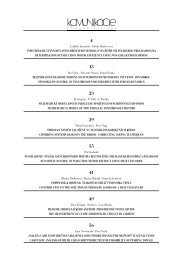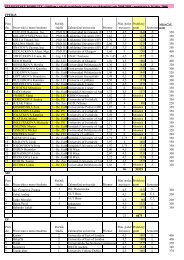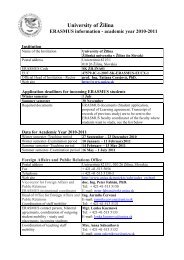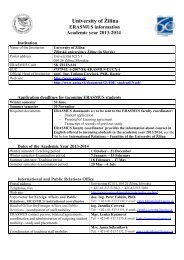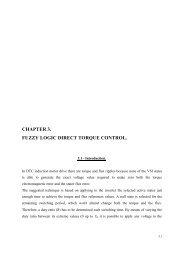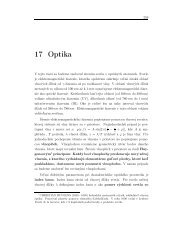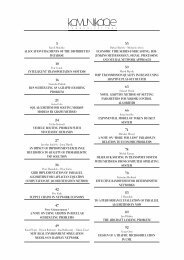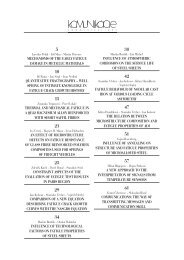simulation of torsion moment at the wheel set of the railway vehicle ...
simulation of torsion moment at the wheel set of the railway vehicle ...
simulation of torsion moment at the wheel set of the railway vehicle ...
You also want an ePaper? Increase the reach of your titles
YUMPU automatically turns print PDFs into web optimized ePapers that Google loves.
T<strong>at</strong>iana Olejnikova *TWO AND THREE-REVOLUTION CYCLICAL SURFACESThe cre<strong>at</strong>ion <strong>of</strong> two-revolution and three-revolution cyclical surfaces is presented in <strong>the</strong> paper. Classific<strong>at</strong>ion and vector equ<strong>at</strong>ions <strong>of</strong> <strong>the</strong>surfaces are given. The surfaces are cre<strong>at</strong>ed by transl<strong>at</strong>ion <strong>of</strong> <strong>the</strong> circle along <strong>the</strong> curves and its centre is on <strong>the</strong> curve. The curves are cre<strong>at</strong>edby revolution <strong>of</strong> a point about any edge <strong>of</strong> <strong>the</strong> trihedron <strong>of</strong> <strong>the</strong> previous curve and this trihedron moves simultaneously along this curve. Allspecific forms <strong>of</strong> surfaces are illustr<strong>at</strong>ed in figures visualized in Maple.1. IntroductionThe point S 1 revolves about <strong>the</strong> coordin<strong>at</strong>e axis z with angularvelocity w 1 in <strong>the</strong> distance d 1 from <strong>the</strong> origin <strong>of</strong> <strong>the</strong> coordin<strong>at</strong>esystem (O, x, y, z). For every value <strong>of</strong> <strong>the</strong> angle w 1 <strong>the</strong>re exists onlyone position <strong>of</strong> <strong>the</strong> point R 1 and <strong>the</strong> trajectory <strong>of</strong> this point R 1 is<strong>the</strong> curve k 1 (circle). The trihedron (R 1 , t 1 , n 1 , b 1 ) defined in everypoint R 1 ∈ k 1 is determined by tangent, principal normal andbinormal <strong>of</strong> <strong>the</strong> curve k 1 . The point S 2 revolves <strong>at</strong> an angularvelocity w 2 about any axis <strong>of</strong> <strong>the</strong> coordin<strong>at</strong>e system, which is identicalwith <strong>the</strong> trihedron (R 1 , t 1 , n 1 , b 1 ) <strong>of</strong> <strong>the</strong> curve k 1 , in <strong>the</strong> distanced 2 from <strong>the</strong> origin <strong>of</strong> this coordin<strong>at</strong>e system which is movingsimultaneously along <strong>the</strong> curve k 1 . For every value <strong>of</strong> <strong>the</strong> angle w 2<strong>the</strong>re exists only one position <strong>of</strong> <strong>the</strong> point R 2 . The trajectory <strong>of</strong>this point R 2 is <strong>the</strong> curve k g 2, where g t, n, b. The trihedron (R 2 ,t 2 , n 2 , b 2 ) in every point R 2 ∈ k g 2 is determined by <strong>the</strong> tangent,principal normal and binormal <strong>of</strong> <strong>the</strong> curve k g 2. The point S 3 revolvesabout any axis <strong>of</strong> <strong>the</strong> coordin<strong>at</strong>e system identical with <strong>the</strong> trihedron(R 2 , t 2 , n 2 , b 2 ) <strong>of</strong> <strong>the</strong> curve k g 2 <strong>at</strong> an angular velocity w 3 in<strong>the</strong> distance d 3 from <strong>the</strong> origin <strong>of</strong> this coordin<strong>at</strong>e system which ismoving simultaneously along <strong>the</strong> curve k g 2. For every value <strong>of</strong> <strong>the</strong>angle w 3 <strong>the</strong>re exists only one position <strong>of</strong> <strong>the</strong> point R 3 . The trajectory<strong>of</strong> <strong>the</strong> point R 3 is <strong>the</strong> curve k g 3 h , where g, h t, n, b. Thetrihedron (R 3 , t 3 , n 3 , b 3 ) in every point R 3 ∈ k g 3 h is determined by<strong>the</strong> tangent, principal normal and binormal <strong>of</strong> <strong>the</strong> curve k g 3 h .The surface <strong>of</strong> <strong>the</strong> type P 1 (u,v) is cre<strong>at</strong>ed by transl<strong>at</strong>ion <strong>of</strong> <strong>the</strong>circle c 1 (R 1 , r 1 ) along <strong>the</strong> curve k 1 , <strong>the</strong> surface <strong>of</strong> <strong>the</strong> typeP g 2(u,v) is cre<strong>at</strong>ed by transl<strong>at</strong>ion <strong>of</strong> <strong>the</strong> circle c 2 (R 2 , r 2 ) along<strong>the</strong> curve k g 2 and <strong>the</strong> surface <strong>of</strong> <strong>the</strong> type P g 3 h (u,v) is cre<strong>at</strong>ed bytransl<strong>at</strong>ion <strong>of</strong> <strong>the</strong> circle c 3 (R 3 , r 3 ) along <strong>the</strong> curve k g 3 h . Theindex g t, n, b determines th<strong>at</strong> <strong>the</strong> point S 2 revolves about <strong>the</strong>tangent t 1 , or principal normal n 1 or binormal b 1 <strong>of</strong> <strong>the</strong> curve k 1and <strong>the</strong> index h t, n, g determines th<strong>at</strong> <strong>the</strong> point S 3 revolvesabout tangent t 2 , principal normal n 2 or binormal b 2 <strong>of</strong> <strong>the</strong> curvek g 2.REVIEW2. Vector functions <strong>of</strong> <strong>the</strong> curves k 1 , k2, g k3 ghLet <strong>the</strong> curve k 1 be a circle cre<strong>at</strong>ed by revolution <strong>of</strong> <strong>the</strong> pointS 1 S 1 (d 1 , 0, 0, 1) about <strong>the</strong> axis z <strong>of</strong> <strong>the</strong> coordin<strong>at</strong>e system (O,x, y, z) <strong>at</strong> an angular velocity w 1 v and k 1 is determined by <strong>the</strong>vector functionr 1 (v) (x k1 (v), y k1 (v), z k1 (v), 1) S 1 . T z1 (w 1 ) (d 1 cos v, s 1 q 1 sin v, 0,1), v ∈ 0, 2π. (1)The m<strong>at</strong>rix T z1 (w 1 ) represents <strong>the</strong> revolution <strong>of</strong> <strong>the</strong> point S 1about <strong>the</strong> coordin<strong>at</strong>e axis z given by (5) (3 rd m<strong>at</strong>rix for i 1),where <strong>the</strong> parameter q 1 1 determines <strong>the</strong> right-turned or leftturnedrevolution movement <strong>of</strong> <strong>the</strong> point (Fig. 1, i 1, j z) [3].We will define <strong>the</strong> trihedron (R 1 , t 1 , n 1 , b 1 ) <strong>of</strong> <strong>the</strong> curve k 1 in everypoint R 1 ∈ k 1 by <strong>the</strong> tangent t 1 , principal normal n 1 and by binormalb 1 with <strong>the</strong>ir unit vectors t 1 (v), n 1 (v), b 1 (v) by equ<strong>at</strong>ions (2),(3), (4) for i 1, v ∈ 0, 2π1 dr1t^vh1 = ^<strong>at</strong>i, bti,ctih= =h1i dv(2)1 dx ^vh kidy ^ki vh dz ^ki vh dr1= e , , o , h1i =h dv dv dv dv1i21 dr1n^vh1 = ^ani, bni,cnih= =2h2i dv22221 dx^ ki vh dy^ ki vh dz^ki vh dr1= f , , p , h222 2i=2h2i dv dv dv dv1b,. (4)h t v n v h t v n vi = _ ^ hi # ^ihi3i = ^ hi # ^ hi3iThe curve k2 g is cre<strong>at</strong>ed by revolution <strong>of</strong> <strong>the</strong> point S 2 in <strong>the</strong>distance d 2 from <strong>the</strong> origin <strong>of</strong> <strong>the</strong> coordin<strong>at</strong>e system (O, x, y, z)about any coordin<strong>at</strong>e axis x, y, or z through <strong>the</strong> angle w 2 into <strong>the</strong>point S 2 (Fig. 1, i 2 for , j x, y, z). Angular velocity w 2 m 1 v(3)* T<strong>at</strong>iana OlejnikovaInstitute <strong>of</strong> Technology, Economics and Management in Civil Engineering, Civil Engineering Faculty, Technical University <strong>of</strong> Kosice, Slovakia,E-mail: t<strong>at</strong>iana.olejnikova@tuke.sk72 ● COMMUNICATIONS 3/2008



